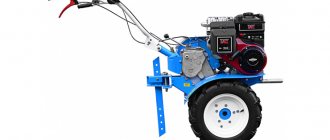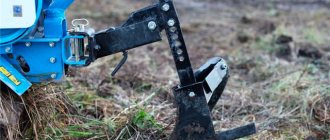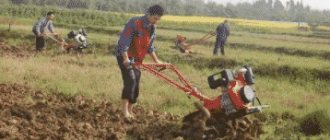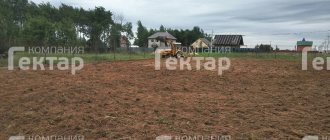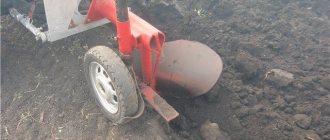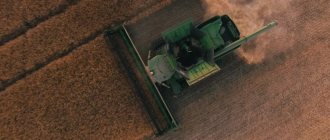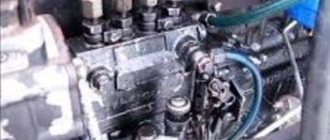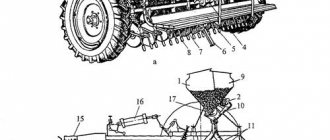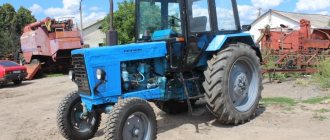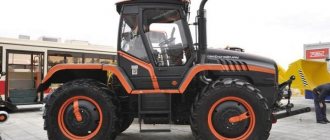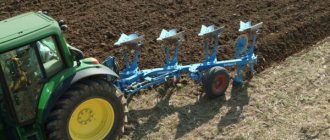Plow adjustment
All plow bodies are adjusted to the same tillage depth by the central link and the right brace of the tractor hitch mechanism. The length of the left brace (between the axis of the upper hinge and the axis of the bolt hole in the fork) should be 515 mm.
An indicator of correct plow adjustment is the horizontal position of its frame. If the frame is tilted forward along the tractor and the front body plows deeper than the rear one, it is necessary to lengthen the central link. If the rear body plows deeper, the central link needs to be shortened.
When working with a plow, the brace with a longitudinal thrust is connected through a hole in the lower fork of the brace. To reduce slipping and increase tractor performance when plowing, use a power regulator or GSV. On soils with increased density, it is recommended to install additional weights on the rear wheel rims. Place 8 weights on the right wheel and 8 weights on the left.
When working with a power regulator, the specified tillage depth is maintained automatically using the power regulator; in this case, the plow support wheel is not used. The working width is adjusted by moving the plow suspension axis in the horizontal plane. To increase the working width of the plow, the left end of the suspension axis must be moved forward along the tractor, and to reduce the working width - back.
To prevent the central link from resting on the rotary shaft when lifting the PKS-3-35 plow, before attaching it to the tractor, it is necessary to limit the piston stroke by the movable stop of the hydromechanical control valve to 100-150 mm instead of 200 mm. To work on soils with high resistivity up to 0.9 kgf/cm2 (0.09 MPa), if necessary, you can re-equip the PN-3-35B “Universal” and PLN-3-35 plows, leaving only two bodies.
The right brace must be adjusted in length so that the plow frame in the furrow does not have a transverse slope. The length of the brace is adjusted in the first three passes (when the plow is installed at the desired depth) depending on the plowing depth. The greater the depth, the shorter the right brace needs to be made. It should be borne in mind that in most cases, when passing the first furrow, it is not possible to obtain a normal plowing depth, since the first body is not able to roll the layer to the side. Usually, when passing the first furrow, the first plow body is launched to half the plowing depth, and the last one to the full depth. To do this, the right brace is shortened and the plow receives some distortion.
It is not allowed to use PLN-3-35B plows on rocky soils. It is necessary to use special plows for rocky soils - PKS-3-35.
06.08.2018
tractor-center.ru
One of the main purposes of the MTZ-80 tractor is plowing the land. For plowing, a trailed or mounted implement called a plow is used. The task of the plow is to turn over a layer of earth to a certain depth in order to cut the roots of weeds and loosen the soil for subsequent sowing of any crop. The main parts of the plow include: - a knife that cuts the soil in a vertical plane; - a skimmer (optional) - removes the top layer of earth with the root system of grasses; - ploughshare - cuts the soil in a horizontal plane; - blade - loosens and turns over the layer; - support wheel - creates support for the plow in a horizontal plane; - field board - gives direction to the plow in a vertical plane.
The design, design, and capabilities of certain types of plows can be found on technical sites and video materials. Based on the principle of connection to the MTZ-80 tractor, plows can be divided into 3 categories:
- trailed - this is a frame - a trailer with a plow on three wheels; - semi-mounted - the plow is connected to the tractor hitch on one side, and on the other side rests on the support wheel; - mounted - the plow is completely connected to the tractor's hitch system and is raised and lowered using hydraulics.
In the marking of a plow, the letters PN indicate that it is a mounted plow; PL or PLP – semi-mounted plows. The first numbers indicate the number of plow bodies, the second number is the plowing width in centimeters. For example, for the MTZ - 80 tractor, according to its traction characteristics, the PLN 3 - 35 plow is suitable, which has three knives and its plowing grip is 35 centimeters. Adjusting the position of the plow on the MTZ-80 mounted system begins with checking the system before starting work in the field. The tractor is installed on a flat area, preferably concrete. Under the left wheels of the MTZ-80 tractor and the support wheel of the plow, spacers made of blocks of wood or other available material are installed to a height equal to the expected plowing depth. At the same time, the tractor will tilt to the right - in this position it will work, since its right wheels will be on an already plowed level, and its left wheels will be on an untouched surface. In this position of the tractor, the adjusting rods must be used to set the surfaces of the plowshares at the level of the concrete surface, that is, the plow frame must be installed horizontally. The support wheel is set with the adjusting screw so that it tightly touches the pads. This completes the preliminary adjustment of the plow. There are good video materials on this topic that will help you understand the operating principles of a particular plow model and adjust it correctly. The field board determines the position of the plow in the furrow by the vertical cut of the furrow. There should be no distortion of the field board relative to the common longitudinal axis of the tractor, otherwise the plow will be pulled in one direction or another from the direction of plowing. Moreover, it is desirable that the heel of the board does not touch the lower level of the arable land and does not wear out; that is, it needs to be raised above the level of the plowshares by a couple of centimeters. Since there are quite a lot of varieties of tractors and trailed plows, in your work it is best to be guided by the technical data sheet of the product or look for the necessary materials for specific equipment on video sites. The rest of the adjustment of the plow on the MTZ-80 tractor is carried out after plowing the first furrow: check the width and depth of the plowing. If there are any deviations from the previous settings, you can further adjust the plow elements based on the results obtained.
If adjusting the plow or its installation and repair is a problem for you, then you can easily solve this problem in a specialized one. Experienced Tractor Service specialists will perform all necessary work in a short time.
What is the point of plowing the land?
The benefits of plowing the land with a tractor in the fall.
Autumn plowing with a tractor within the boundaries of future sown areas is carried out to loosen the top layer of soil in order to increase its fertility. Plowing the soil before winter is carried out to saturate the soil with oxygen, create conditions for weeds to freeze, as well as destroy the underground passages of moles, mole crickets, voles, mice, gophers and other crop pests.
Once upon a time there was a term “fall plowing”, because the cultivation of the land was timed to coincide with the onset of the first frost, in other words, the land was cold and frozen. Most of the larvae - future pests - fall to the surface and die from the cold, and the underground communication systems of rodents are eliminated.
In addition, loosened soil absorbs more moisture, which stimulates an increase in yield in the next season. During arable work, for effectiveness, it is recommended to manure the soil and apply fertilizers.
Plowing in the spring is the basis for the future harvest.
Spring plowing of the land is done with a tractor cutter for loosening
The variety and density of plantings of crops that are supposed to be sown in a given area dictate the depth of plowing. The technology of mechanized cultivation of land for fodder root crops during pre-sowing tillage uses deeper plowing; such depth is not required for cereal plants.
Following the order of cultivating the soil layer with a tractor promotes loosening and protects it from salinization and erosion.
Features of a plow on a walk-behind tractor
When choosing a walk-behind tractor, you should take into account the area to be processed and the condition of the soil.
The following types of walk-behind construction are distinguished:
- lungs;
- average;
- heavy.
The first option is used in areas with a small area. These are small-sized devices with an engine whose power does not exceed 5 hp. An essential feature of such motor cultivators is that they cannot be used for a long time. Due to their light weight and low-power motor, they are not able to dig deeply into the ground and quickly overheat.
The second type, in most cases, has rear-wheel drive and does an excellent job in large areas. The weight of the car has been increased and they can corner easily. Engine power can reach up to 12 hp.
Heavy representatives of walk-behind tractors are equipped with a power unit with a capacity of 15-30 horsepower. You can attach any additional equipment to them (potato digger, plow, trailer). Quite powerful equipment and at the same time very inconvenient when making a turn.
Which tractor is best for plowing?
When choosing a particular row-crop tractor, you should pay attention to certain criteria:
- brand – each brand differs in functionality and price range, so before purchasing, study in detail each brand that is presented on the agricultural market;
- power - this indicator must ensure the execution of the proposed work;
- tractor resource – for small farms and farms, a unit with a small and medium resource is ideal.
Having studied and analyzed these basic criteria in detail, you will be able to choose exactly the tractor that is ideal for your farm.
Do-it-yourself plow to walk-behind tractor
For someone who knows how to handle a tool and is trained to work with a welding machine, it will not be difficult to make a mechanism for plowing a garden with a walk-behind tractor on their own. It is enough to prepare the material: metal sheets, bolts, corner. Moreover, the products may not be new, but already used, but in good condition.
The ploughshare is made of a three-millimeter steel sheet. The remaining elements are made from a strip and a corner. The parts of the plow are connected to each other by welding and then the joints are cleaned with a grinder. Some are mounted in double rows to avoid a second pass at the beginning of the lane when driving in parallel rows.
Independent production of drawings and structural elements requires special attention. The precision of manufacturing parts will eliminate the possibility of disturbances in the functioning of the whole organism.
Modern designs of plows have a large number of varieties: single- and double-hulled, moldboard and non-mouldboard, rotary and rotary.
Advantages of homemade equipment:
- the ability to carry out accurate measurements and calculations on site;
- the cost of the finished structure will be cheaper than a similar factory one;
- selection of quality material;
- The assembly of the structure is carried out under constant supervision.
Is it possible to plow the land in the rain? Is it better to plow the garden before or after the rains?
It's better to plow the garden. If you have a choice, in the fall it is better BEFORE the rains, although this option is more tiring for a person. But in the spring, ideally immediately after rain, then the soil inside will become more moist, which is important for the planting and growth of any plants. Although there is one more point - earthworms, which improve the structure and composition of the soil, are really damaged after rain, as they crawl to the surface. Thus, to decide when is the best time to plow, you need to be guided by specific conditions and goals.
replied 2015-08-28T16:04:03.000000+03:00 4 years, 2 months ago
Of course, before the rains, I only managed to dig up part of the garden. Today it rained quite heavily, where it has been dug up, the soil looks nice and tidy, it doesn’t spread into the mud, unlike last year. Now it will be very difficult to dig, the ground is wet and heavy. I'll dig when it dries out a little. You can even dig in the snow, especially so that there are no pests in the ground.
replied 2015-08-28T16:51:33.000000+03:00 4 years, 2 months ago
The soil has optimal moisture, they say its ripeness, then it loosens best and energy costs are less. In spring, the soil is at first very moist, the layer turns over well, it is easy to plow, but it does not loosen at all, it remains united, then it becomes ripe, then, as it dries, it is already difficult to plow or dig, as it becomes too hard. There is very little time to plow on time, it is not without reason that they say that in the spring one day feeds the year. This problem will not occur if watering is possible. There may be a very dry spring or fallow plowing in the summer, or a dry autumn, you can water the field before plowing and then huge lumps will not form. When the soil is very damp, there is nothing left to do but wait for fine days.
Preparing for plowing
Before planting seedlings and sowing seeds of agricultural crops, the soil must be prepared and the top layer must first be plowed. This work can be easily done by a motor cultivator plow. A correctly adjusted mechanism will create a neat and even furrow. To begin with, preparatory work is carried out with the walk-behind tractor itself, it is transported to the place where work begins, inspected and prepared for installation of the plow. Then it is fixed and adjusted, if necessary, sharpened. Only after this they start plowing.
Settings
The motor-cultivator is brought to the place where work begins in a disassembled state: the lugs and attachments must be removed:
- The wheels are dismantled to install special lugs instead. Without these devices, plowing the land will be problematic.
- Improves the stability of the walk-behind tractor. To do this, the hubs of the wheel pair are removed and other, more elongated ones are installed in their place. Thus, the distance between the lugs increases and the mini-tractor is better controlled while driving.
- Direct installation of lug devices.
Adjustment
For ease of adjustment, you need to take a beam 15 centimeters high in the amount of 2 pieces. They will serve as stands. Next, adjust the plowing depth. The most optimal is 16-20 centimeters. The entire procedure takes place on a flat horizontal surface. Now you can adjust the angle of inclination of the plow structure:
- Its rear part is raised by turning a special adjusting bolt. Thus, the depth of the furrow increases.
- By turning the bolt back, you can reduce the plowing depth.
Advice. The distance between the plow and the ground level should be maintained no more than 5 centimeters. If it is less than 3, the plow will dig into the soil and the quality of plowing will be poor. In this case, the engine will feel an increase in load, which will negatively affect its further performance.
Before starting the main work, you should plow a test strip and check the result. First of all, pay attention to the following:
- Strip depth, blade condition.
- While moving, monitor the progress of the plow.
- Smooth running of the walk-behind tractor.
- Engine operation and operator's physical workload.
The control strip is executed in the following sequence:
- The mini-tractor is placed on the edge of the cultivated plot of land.
- The gear is engaged and the clutch is smoothly depressed. When moving, you need to make sure that the walk-behind tractor with the plow runs parallel to the surface of the ground, without burying or rising too much. In this case, you don’t need to put in much effort; the motorcycle will move forward on its own.
- Check the result of the first strip passed; if it corresponds to the required depth, then work can begin in full.
Sharpening
The main structural element of the plow, which bears the main load during plowing, is the ploughshare. To effectively cut the ground, it must be well sharpened. Otherwise, dull blades will slow down the plow's forward progress. Many people try to make a plow themselves and, as a result, are not very happy with their work. And all because there is not enough knowledge about the production of a plowshare and how to sharpen it. The ploughshare must be removable with a cutting edge slightly thicker than 1 millimeter and an angle of 25 to 40 degrees. Of course, it is best to purchase a finished product, but you can try to make a good plow for a walk-behind tractor yourself, using diagrams and drawings, as well as a huge number of videos presented on the Internet.
Basic requirements for the ploughshare:
- the blade (its edge) should be located 2 cm below the skid;
- the blade and the working plane of the ploughshare must fit tightly together without gaps;
- the rear surface is attached to the base of the plow at an angle of 20 degrees, but no more;
- The cutting edge is made of carbide with a 4 mm chamfer.
A dull blade leads to poor penetration of the plow into the ground. This means it needs to be sharpened. How to do this correctly? The best place where such work will be performed at the highest level is a forge. In it, the material is first heated to a high temperature, then worn areas are corrected using a sledgehammer. Next, the blade is sharpened and hardened.
Modern manufacturers of agricultural machinery and tools produce self-sharpening blades. How to get out of the situation if there is neither one nor the other? In this case, use regular sandpaper. Sharpening occurs from the side of the influx of earth at a slight angle to the front surface.
Installation
The time has come to install the plow on the walk-behind tractor. But first you need to attach the hitch to it:
- The tools necessary for the work are laid out: keys, hitch, plow.
- The furrow depth is adjusted. The hole of the hub and the plow stand are compared.
- The holes are secured with a common bolt.
- The installed hitch on the plow is fixed with bolted connections.
- The structure is hung on a walk-behind tractor.
The use of row crop tractors with a plow
Row-crop tractors are mainly used for plowing, plowing and all basic agricultural work. These vehicles have powerful engines and are distinguished by large track width and ground clearance. And some models are also equipped with interchangeable drive wheels with wide and narrow tires for general work and row-spacing.
In addition to row crops, special tractors are used to work with the plow. They are necessary when cultivating soil in specific conditions of swampy or mountainous areas, to care for certain types of crops. Only after assessing all the conditions in which the field has to be cultivated and the modification of the machines, experts choose which tractor is best for plowing.
